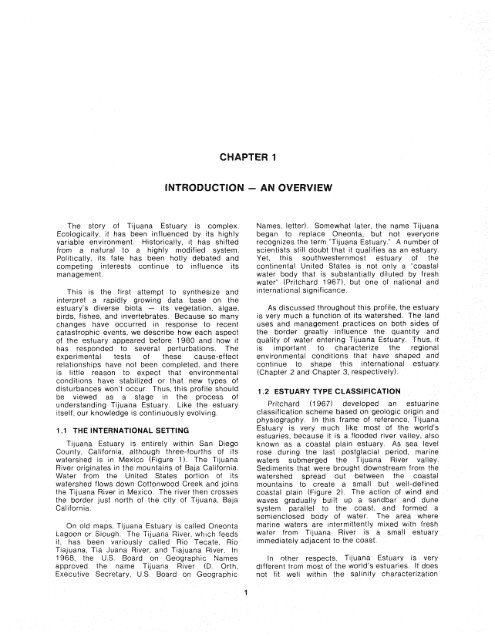The Ecology of Tijuana Estuary, California: An Estuarine Profile
The Ecology of Tijuana Estuary, California: An Estuarine Profile
The Ecology of Tijuana Estuary, California: An Estuarine Profile
Create successful ePaper yourself
Turn your PDF publications into a flip-book with our unique Google optimized e-Paper software.
CHAPTER 1<br />
ONTROBkBCTiON - AN OVERVlEW<br />
<strong>The</strong> story <strong>of</strong> <strong>Tijuana</strong> <strong>Estuary</strong> is complex.<br />
Ecologically, it has been influenced by its highly<br />
variable environment. Historically, it has shifted<br />
from a natural to a highly modified system.<br />
Politically, its fate has been hotly debated and<br />
competing interests continue to influence its<br />
management.<br />
This is the first attempt to synthesize and<br />
interpret a rapidly growing data base on the<br />
estuary's diverse biota - its vegetation, algae,<br />
birds, fishes, and invertebrates. Because so many<br />
changes have occurred in response to recent<br />
catastrophic events, we describe how each aspect<br />
<strong>of</strong> the estuary appeared before 1980 and how it<br />
has responded to several perturbations. <strong>The</strong><br />
experimental tests <strong>of</strong> these cause-effect<br />
relationships have not been completed, and there<br />
is little reason to expect that environmental<br />
conditions have stabilized or that new types <strong>of</strong><br />
disturbances won't occur. Thus, this pr<strong>of</strong>ile should<br />
be viewed as a stage in the process <strong>of</strong><br />
understanding <strong>Tijuana</strong> <strong>Estuary</strong>. Like the estuary<br />
itself, our knowledge is continuously evolving.<br />
1.1 THE lMTERNATlONAL SETTING<br />
<strong>Tijuana</strong> <strong>Estuary</strong> is entirely within San Diego<br />
County, <strong>California</strong>, although three-fourths <strong>of</strong> its<br />
watershed is in Mexico (Figure 1). <strong>The</strong> <strong>Tijuana</strong><br />
River originates in the mountains <strong>of</strong> Baja <strong>California</strong>.<br />
Water from the United States portion <strong>of</strong> its<br />
watershed flows down Cottonwood Creek and joins<br />
the <strong>Tijuana</strong> River in Mexico. <strong>The</strong> river then crosses<br />
the border just north <strong>of</strong> the city <strong>of</strong> <strong>Tijuana</strong>, Baja<br />
<strong>California</strong>.<br />
On old maps, <strong>Tijuana</strong> <strong>Estuary</strong> IS called Oneonta<br />
Lagoon or Siough <strong>The</strong> T~tudna River, which feeds<br />
it, has been variously called Rio Tecate, Rio<br />
Tlajuana, Tla Juana River, and Tiajuana River In<br />
1968, the U S Board on Geograph~c Names<br />
approved the name <strong>Tijuana</strong> River fD Orth,<br />
Executive Secretary, U S Board on Geographic<br />
Names, letter). Somewhat later, the name <strong>Tijuana</strong><br />
began to replace Oneonta, but not everyone<br />
recognizes the term "<strong>Tijuana</strong> <strong>Estuary</strong>." A number <strong>of</strong><br />
scientists still doubt that it qualifies as an estuary.<br />
Yet, this southwesternmost estuary <strong>of</strong> the<br />
continental United States is not only a "coastal<br />
water body that is substantially diluted by fresh<br />
water" (Pritchard 19671, but one <strong>of</strong> national and<br />
international significance.<br />
As discussed throughout this pr<strong>of</strong>ile, the estuary<br />
IS very much a function <strong>of</strong> ~ts watershed <strong>The</strong> land<br />
uses and management practices on both sides <strong>of</strong><br />
the border greatly influence the quantity and<br />
quality <strong>of</strong> water entering <strong>Tijuana</strong> <strong>Estuary</strong> Thus, it<br />
IS ~mportant to characterize the regional<br />
env~ronmental conditions that have shaped and<br />
cont~nue to shape this international estuary<br />
(Chapter 2 and Chapter 3, respectively)<br />
1.2 ESTUARY TYPE CLASSlFlCATlON<br />
Pritchard (1967) developed an estuar~ne<br />
classification scheme based on geologic origin and<br />
phystography In this frame <strong>of</strong> reference, <strong>Tijuana</strong><br />
<strong>Estuary</strong> is very much l~ke most <strong>of</strong> the world's<br />
estuaries, because it is a flooded rlver valley, also<br />
known as a coastal plaln estuary As sea level<br />
rose during the last postglacial per~od, marine<br />
waters submerged the <strong>Tijuana</strong> River valley<br />
Sed~ments that were brought downstream from the<br />
watershed spread out between the coastal<br />
mountains to create a small but well-defrned<br />
coastal plain (Figure 2) <strong>The</strong> action <strong>of</strong> wind and<br />
waves gradually bu~lt up a sandbar and dune<br />
system parallel to the coast, and formed a<br />
semienclosed body <strong>of</strong> water <strong>The</strong> area where<br />
marlne waters are interm~ttently mlxed with fresh<br />
water from <strong>Tijuana</strong> River is a small estuary<br />
immediately adjacent ta the coast<br />
In other respects, <strong>Tijuana</strong> <strong>Estuary</strong> is very<br />
d~fferent from most <strong>of</strong> the world's estuaries ft does<br />
not fit well within the salinity character~zalion

















